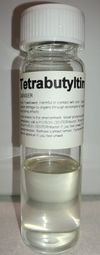Difference between revisions of "Tetrabutyltin"
| Line 62: | Line 62: | ||
| MeltingPt_ref = | | MeltingPt_ref = | ||
| MeltingPt_notes = | | MeltingPt_notes = | ||
| − | | Odor = | + | | Odor = Faint, distinctive |
| pKa = | | pKa = | ||
| pKb = | | pKb = | ||
| Line 119: | Line 119: | ||
===Physical=== | ===Physical=== | ||
Tetrabutyltin is a colorless liquid, with a density similar to that of water. It is not soluble in water, but it's miscible with many organic solvents. Tetrabutyltin has a boiling point of 245 °C at standard conditions, which can be lowered to 127-145 °C by lowering the air pressure to 10 mmHg. This is preferred, as the compound decomposes close to 265 °C, which is very close to its boiling point. | Tetrabutyltin is a colorless liquid, with a density similar to that of water. It is not soluble in water, but it's miscible with many organic solvents. Tetrabutyltin has a boiling point of 245 °C at standard conditions, which can be lowered to 127-145 °C by lowering the air pressure to 10 mmHg. This is preferred, as the compound decomposes close to 265 °C, which is very close to its boiling point. | ||
| + | |||
| + | Tetrabutyltin has a faint distinctive smell, difficult to describe. | ||
==Availability== | ==Availability== | ||
Latest revision as of 21:02, 1 November 2020
 Sample of SnBu4
| |
| Names | |
|---|---|
| IUPAC names
Tetra-n-butylstannane
Tetra-n-butyltin | |
| Other names
SnBu4
TBT Tetrabutyl tin Tetrabutylstannane | |
| Properties | |
| C16H36Sn (C4H9)4Sn SnBu4 | |
| Molar mass | 347.147 g/mol |
| Appearance | Colorless liquid |
| Odor | Faint, distinctive |
| Density | 1.054 g/cm3 (20 °C) |
| Melting point | −97 °C (−143 °F; 176 K) |
| Boiling point | 245 °C (473 °F; 518 K) |
| 0.0008 g/100 ml | |
| Solubility | Miscible with benzene, diethyl ether, THF |
| Vapor pressure | 0.0048 mm Hg at 20 °C |
| Hazards | |
| Safety data sheet | Sigma-Aldrich |
| Flash point | 107 °C (225 °F; 380 K) |
| Lethal dose or concentration (LD, LC): | |
| LD50 (Median dose)
|
2,500 mg/kg (rat, oral)[1] |
| Except where otherwise noted, data are given for materials in their standard state (at 25 °C [77 °F], 100 kPa). | |
| Infobox references | |
Tetrabutyltin is the organotin compound with the formula (C4H9)4Sn or SnBu4. It is one of the few stable liquid organometallic compounds that can be handled (relative) safely without requiring special conditions.
Contents
Properties
Chemical
By the redistribution reaction with tin(IV) chloride, SnBu4 forms tributyltin chloride and dibutyltin chloride.
TBT reacts easily with halogens, hydrogen halides and most acids.
Physical
Tetrabutyltin is a colorless liquid, with a density similar to that of water. It is not soluble in water, but it's miscible with many organic solvents. Tetrabutyltin has a boiling point of 245 °C at standard conditions, which can be lowered to 127-145 °C by lowering the air pressure to 10 mmHg. This is preferred, as the compound decomposes close to 265 °C, which is very close to its boiling point.
Tetrabutyltin has a faint distinctive smell, difficult to describe.
Availability
Can be bought from chemical suppliers.
Preparation
Tetrabutyltin can be prepared by reaction of tin(IV) chloride with the Grignard reagent of n-butyl chloride.
- SnCl4 + 4 BuMgCl → SnBu4 + 4 MgCl2
Tetrabutyltin can be prepared by a Wurtz reaction from tin(IV) chloride, n-butyl chloride and sodium metal. The yield of this reaction is 65%. To limit the formation of tin metal, due to the sodium reduction of stannic chloride, dibutyltin dichloride may be used instead, if available.[2]
The classical route of obtaining tetraalkyl organometallic compounds, in this case between sodium-tin alloy and n-butyl chloride has not been studied.
Projects
- Make stabilizers for PVC
- Compound collecting
Handling
Safety
Tetrabutyltin is not very volatile, so its vapors aren't very dangerous. As a liquid it shows moderate toxicity, although consumption of this compound has been described as being "fatal".[3] The LD50 for this compound has been given as 2,500 mg/kg for rat.
Storage
In glass vials, away from light and air.
Disposal
Can be neutralized with an acid to tin salts and butyl compounds, which can be separated and further neutralized.
References
- ↑ https://echa.europa.eu/registration-dossier/-/registered-dossier/13445/7/3/1
- ↑ https://onlinelibrary.wiley.com/doi/abs/10.1002/jctb.5010040605
- ↑ https://echa.europa.eu/substance-information/-/substanceinfo/100.014.510